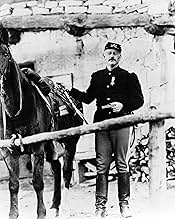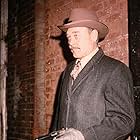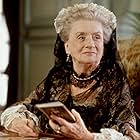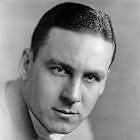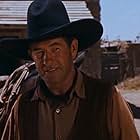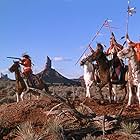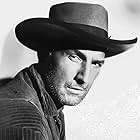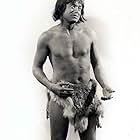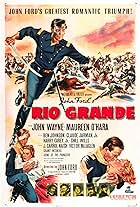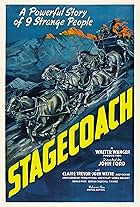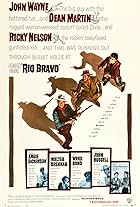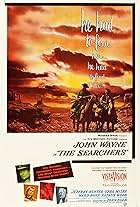Captain Nathan Brittles, on the eve of retirement, takes out a last patrol to stop an impending massive Indian attack. Encumbered by women who must be evacuated, Brittles finds his mission i... Read allCaptain Nathan Brittles, on the eve of retirement, takes out a last patrol to stop an impending massive Indian attack. Encumbered by women who must be evacuated, Brittles finds his mission imperiled.Captain Nathan Brittles, on the eve of retirement, takes out a last patrol to stop an impending massive Indian attack. Encumbered by women who must be evacuated, Brittles finds his mission imperiled.
- Won 1 Oscar
- 1 win & 1 nomination total
George Sky Eagle
- Chief Sky Eagle
- (as Chief Sky Eagle)
Rudy Bowman
- Pvt. John Smith - aka Rome Clay
- (uncredited)
Lee Bradley
- Interpreter
- (uncredited)
Storyline
Did you know
- TriviaJohn Wayne, who was 41 when the film was made, won great acclaim for his portrayal of 60-year-old Capt. Nathan Brittles.
- GoofsThe narration refers to the Battle of Little Bighorn, which took place in June of 1876. It also states that one of the ways the news of this was spread was via the Pony Express. The Pony express was founded in April of 1860 and ceased operations a year and a half later, in October of 1861. This was 15 years before the battle.
- Quotes
Captain Nathan Brittles: Never apologize. It's a sign of weakness.
- ConnectionsFeatured in The Siege at Red River (1954)
- SoundtracksShe Wore A Yellow Ribbon
(uncredited)
Heard over opening credits, in score and sung by troopers
Featured review
The second of John Ford's cavalry trilogy that deals with the life of the professional soldier is the only one that was photographed in color. Lucky are we, the cinema fans two generations away.
She Wore A Yellow Ribbon has John Wayne the embodiment of the thirty year army man. The year of the action of the film which is 1876 has Wayne mentioning in passing that he was at the Battle of Chapultepec in the Mexican War which started in 1846. Wayne's Nathan Brittles was by his account a dirty shirt tailed runaway from his father's Ohio farm when he joined the army. And now he's reached mandatory retirement. He's married and has had a family who he's lost for reasons John Ford doesn't explain in the film. But Wayne dutifully, "makes his report" at their gravesides every night he's at the post.
Wayne's seen a lot of military history and a lot of tragedy. With no family left, the United States Cavalry is his home and family. He doesn't like the idea of retiring at all. In a later Ford film, The Long Gray Line, Martin Maher says that all he knows and holds dear is at West Point. Wayne could have said that line himself here.
Even though George O'Brien is the commanding officer at Fort Stark, Wayne is the father figure for the whole post. And not like some of the others don't behave like children. The whole romantic rivalry between John Agar and Harry Carey, Jr. over Joanne Dru seems pretty childish. Cute while in the safety of the post, but when out on a mission downright dangerous and Wayne like the good father scolds his kiddies.
With some makeup to grey his hair and wrinkle him a might, Wayne turns in one of his finest performances on the screen. Harry Carey, Jr. wrote what is probably the most evenly balanced portrayal of the Duke in his memoirs In the Company of Heroes. They didn't always get along, but Carey says Wayne was an inspiration to him and the other younger cast members. In fact during the scene with the gunrunners Paul Fix and Grant Withers being killed in the Indian camp while Wayne, Carey, and Agar watch on the ridge, the whole idea for the chaw of tobacco bit came from Carey himself, but that Wayne encouraged the improvisation as he was wont to do.
Other than the Duke, my favorite portrayal in the film is that of Ben Johnson as Sergeant Tyree. Wayne recognizes in him a younger version of himself. In fact Tyree is a former Confederate Army captain, a fact brought out in the death scene of "Trooper Smith" another former Confederate who in fact was a general in that army. Ben Johnson was a real cowboy, a horse wrangler who John Ford gave a chance to act. He graced many a film with his presence and won himself an Oscar to cap his career in The Last Picture Show.
Like in Fort Apache and Rio Grande, She Wore a Yellow Ribbon is the story of the professional soldier and the sacrifices he makes when he gives up his civilian status to serve his country. It's a universal theme, not just confined to the USA. No one embodied that theme better than did John Wayne as Nathan Brittles in She Wore a Yellow Ribbon.
She Wore A Yellow Ribbon has John Wayne the embodiment of the thirty year army man. The year of the action of the film which is 1876 has Wayne mentioning in passing that he was at the Battle of Chapultepec in the Mexican War which started in 1846. Wayne's Nathan Brittles was by his account a dirty shirt tailed runaway from his father's Ohio farm when he joined the army. And now he's reached mandatory retirement. He's married and has had a family who he's lost for reasons John Ford doesn't explain in the film. But Wayne dutifully, "makes his report" at their gravesides every night he's at the post.
Wayne's seen a lot of military history and a lot of tragedy. With no family left, the United States Cavalry is his home and family. He doesn't like the idea of retiring at all. In a later Ford film, The Long Gray Line, Martin Maher says that all he knows and holds dear is at West Point. Wayne could have said that line himself here.
Even though George O'Brien is the commanding officer at Fort Stark, Wayne is the father figure for the whole post. And not like some of the others don't behave like children. The whole romantic rivalry between John Agar and Harry Carey, Jr. over Joanne Dru seems pretty childish. Cute while in the safety of the post, but when out on a mission downright dangerous and Wayne like the good father scolds his kiddies.
With some makeup to grey his hair and wrinkle him a might, Wayne turns in one of his finest performances on the screen. Harry Carey, Jr. wrote what is probably the most evenly balanced portrayal of the Duke in his memoirs In the Company of Heroes. They didn't always get along, but Carey says Wayne was an inspiration to him and the other younger cast members. In fact during the scene with the gunrunners Paul Fix and Grant Withers being killed in the Indian camp while Wayne, Carey, and Agar watch on the ridge, the whole idea for the chaw of tobacco bit came from Carey himself, but that Wayne encouraged the improvisation as he was wont to do.
Other than the Duke, my favorite portrayal in the film is that of Ben Johnson as Sergeant Tyree. Wayne recognizes in him a younger version of himself. In fact Tyree is a former Confederate Army captain, a fact brought out in the death scene of "Trooper Smith" another former Confederate who in fact was a general in that army. Ben Johnson was a real cowboy, a horse wrangler who John Ford gave a chance to act. He graced many a film with his presence and won himself an Oscar to cap his career in The Last Picture Show.
Like in Fort Apache and Rio Grande, She Wore a Yellow Ribbon is the story of the professional soldier and the sacrifices he makes when he gives up his civilian status to serve his country. It's a universal theme, not just confined to the USA. No one embodied that theme better than did John Wayne as Nathan Brittles in She Wore a Yellow Ribbon.
- bkoganbing
- Aug 23, 2005
- Permalink
- How long is She Wore a Yellow Ribbon?Powered by Alexa
Details
- Release date
- Country of origin
- Languages
- Also known as
- La legión invencible
- Filming locations
- Goulding's Trading Post, Monument Valley, Utah, USA(was used as part of the army post)
- Production company
- See more company credits at IMDbPro
Box office
- Budget
- $1,600,000 (estimated)
- Runtime1 hour 44 minutes
- Aspect ratio
- 1.37 : 1
Contribute to this page
Suggest an edit or add missing content

Top Gap
By what name was She Wore a Yellow Ribbon (1949) officially released in India in English?
Answer







